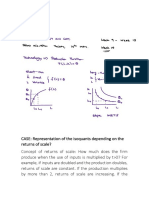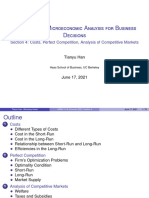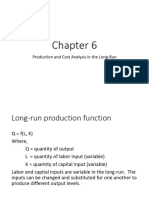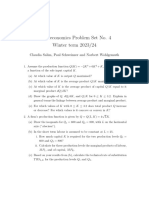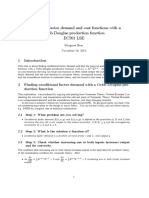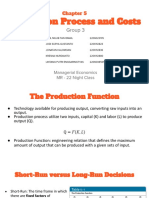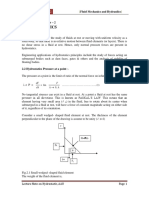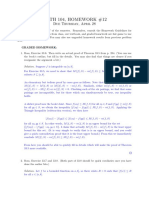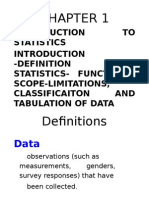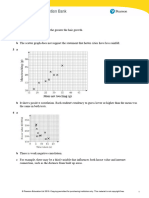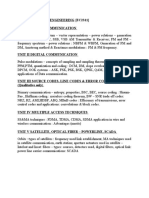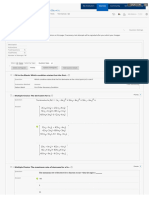Microeconomics - LUISS Guido Carli
Assignment 3
Professor
Lorenzo Ferrari
18/04/2023
1. A firm operates with the following fixed-proportion production function:
nL o
Q = f (L, K) = min ,K .
3
Answer the following questions:
(a) Compute the marginal products of L and K for this production function, i.e.,
M PL and M PK .
Solution
As the production function employs inputs in fixed proportions Q is equal to the
smaller of L/3 and K. In other words:
L
• > K or L > 3K =⇒ f (L, K) = f (K) = K.
3
L L
• < K or L < 3K =⇒ f (L, K) = f (L) = .
3 3
L L
• = K or L = 3K =⇒ f (L, K) = = K.
3 3
Notice that in the last case the L and K yield exactly the same amount of output.
Similarly, M PL and M PK also depend on the relation between L/3 and K:
L
• > K or L > 3K =⇒ M PL = 0, M PK = 1.
3
L 1
• < K or L < 3K =⇒ M PL = , M PK = 0.
3 3
L
• = K or L = 3K =⇒ M PL = 0, M PK = 0.
3
1
�Notice that in the last case increasing L or K alone does not increase output.
(b) Compute the marginal rate of technical substitution (M RT SK,L ) between
labor and capital (Hint: you can use the two cases identified above).
Solution
The M RT SK,L is given by the ratio of marginal products. This depends once again
on the relation between L/3 and K:
L 0
• > K or L > 3K =⇒ M RT SK,L = = 0.
3 1
L 1/3
• < K or L < 3K =⇒ M RT SK,L = = ∞.
3 0
L 0
• = K or L = 3K =⇒ M RT SK,L = (undefined).
3 0
Notice that the first and second cases correspond respectively to the horizontal
and vertical regions of the isoquant. The third case corresponds to the kink of the
isoquant, where M RT SK,L is not defined.
(c) Use a properly-labelled graph to draw some of the isoquants corresponding to
this production function. What is the slope of isoquants?
Solution
Figure 1: Isoquants in exercise 1, point (c).
2
�(d) Derive the firm’s long-run demand for L and K for generic w, r > 0, and
Q ≥ 0.
Solution
The production function employs L and K in fixed proportions. Hence, the cost-
minimising combination of inputs will be such that:
L
= K =⇒ L = 3K.
3
To produce each unit of output the firm employs 3 units of L and 1 unit of K. As
a consequence, the long-run demand for L and K is exclusively a function of Q and
does not depend on w and r:
L(Q) = 3Q and K(Q) = Q.
(e) Find the long-run total cost function T C(w, r, Q) = wL(w, r, Q)+rK(w, r, Q).
Solution
T C(w, r, Q) = wL(Q) + rK(Q) = w(3Q) + rQ = (3w + r)Q.
(f) Write the long-run total cost function when w = 1 and r = 2.
Solution
T C(w = 1, r = 2, Q) = (3 + 2)Q = 5Q.
(g) Draw T C(w = 1, r = 2, Q) on a properly labelled graph.
Solution
Shown in Figure 2 below.
(h) On the same graph as in point (c), assuming w = 1 and r = 2, show:
• Some isocosts (Hint: you can use T C(w = 1, r = 2, Q));
• The firm’s long-run cost-minimising combination of inputs corresponding
to some non-negative quantities; and,
• The long-run expansion path facing the firm.
3
� Figure 2: Long-run total cost curve in exercise 1, point (g).
Solution
To draw isocosts, set:
T C(Q) = 5Q = L + 2K.
Hence (these are just some examples):
5
T C(1) = 5 = L + 2K =⇒ K = − L.
2
4
� T C(2) = 10 = L + 2K =⇒ K = 5 − L.
15
T C(3) = 15 = L + 2K =⇒ K = − L.
2
T C(4) = 20 = L + 2K =⇒ K = 10 − L.
Notice that each isocost touches the corresponding isoquant at its kink. The long-
run expansion path is obtained by connecting the cost-minimising combinations of
inputs for different levels of output.
Figure 3: Isocosts and long-run expansion path in exercise 1, point (h).
Suppose that the firm operates in the short run with a fixed level of capital K̄ = 4.
(i) Derive the short-run demand for L for generic w, r > 0, K̄ = 4, and Q ≥ 0.
Solution
Remember that the firm faces a fixed-proportions production function, i.e., it must
employ 3 units of L for each unit of K. Hence, it will not be possible to produce any
quantity larger than the one allowed by K̄ = 4, i.e., 0 ≤ Q ≤ 4. As a consequence:
L(Q) = 3Q for 0 ≤ Q ≤ 4.
Notice that short-run labor demand is not defined for Q > 4.
(j) Find the short-run total cost function ST C(Q) = wL(w, r, K̄ = 4, Q) + rK̄.
5
�Solution
The short-run total production cost is composed of fixed costs (rK̄ = 4r) and
variable costs (wL). In this particular case, also remember that 0 ≤ Q ≤ 4. Hence:
(
4r if Q = 0
ST C(w, r, K̄ = 4, Q) =
4r + w(3Q) if 0 < Q ≤ 4
Again, notice that the short-run total cost is not defined for Q > 4.
(k) Write the short-run total cost function when w = 1 and r = 2.
Solution
(
8 if Q = 0
ST C(w, r, K̄ = 4, Q) =
8 + 3Q if 0 < Q ≤ 4
(l) Draw ST C(w = 1, r = 2, K̄ = 4, Q) on the same graph as in point (g).
Carefully discuss your findings.
Solution
Shown in Figure 4 below. Notice that T C(4) = ST C(4) as K = 4 minimises the
cost of producing Q = 4 both in the short and in the long run. Moreover:
ST C(w = 1, r = 2, K̄ = 4, Q > T C(w = 1, r = 2, Q) ∀ Q ̸= 4.
(m) On the same graph as in point (c), assuming w = 1 and r = 2, show:
• The firm’s short-run cost-minimising combination of inputs correspond-
ing to some non-negative quantities; and,
• The short-run expansion path facing the firm.
Solution
Shown in Figure 5 below. Notice that the long and short-run expansion paths
coincide when Q = 4.
6
� Figure 4: Long-run and short-run total cost curves in exercise 1, point (l).
(n) Use T C(Q) and ST C(Q) found in points (c) and (f) to compute M C(Q),
AC(Q), SM C(Q), AV C(Q), AF C(Q), and SAC(Q).
Solution
∆T C(Q)
• M C(Q) = = 5.
∆Q
T C(Q)
• AC(Q) = = 5.
Q
∆ST C(Q)
• SM C(Q) = = 3 for 0 ≤ Q ≤ 4.
∆Q
7
� T V C(Q)
• AV C(Q) = = 3 for 0 ≤ Q ≤ 4.
Q
FC 8
• AF C(Q) = = for 0 ≤ Q ≤ 4.
Q Q
8
• SAC(Q) = AF C(Q) + AV C(Q) = + 3 for 0 ≤ Q ≤ 4.
Q
Figure 5: Short-run expansion path in exercise 1, point (m).
(o) Does this production function display decreasing, increasing, or constant re-
turns to scale? Explain.
Solution
To check returns to scale, multiply both inputs by a factor λ > 1:
n L o nL o
f (λL, λK) = min λ , λK = λ min , K = λf (L, K).
3 3
Hence, this production function displays constant returns to scale.
8
�2. A firm operates with the following production function:
Q = f (L, K) = 2L + K.
(a) Compute the marginal products of L and K for this production function, i.e.,
M PL and M PK .
Solution
∆f (L, K) ∆f (L, K)
M PL = = 2 and M PK = = 1.
∆L ∆K
Notice that, as the production function is linear, M PL and M PK are constant.
Moreover, one unit of L is twice as productive as one unit of K.
(b) Compute the marginal rate of technical substitution (M RT SK,L ) between
labor and capital.
Solution
M RT SK,L is constant and equal to:
M PL
M RT SK,L = = 2.
M PK
(c) Use a properly-labelled graph to draw some of the isoquants corresponding to
this production function.
Solution
Shown in Figure 6 below.
(d) Derive the firm’s long-run demand for L and K for generic w, r > 0, and
Q ≥ 0.
Solution
As the production function is linear, the cost-minimising combination of inputs
crucially depends on the relation between M RT SK,L and w/r. In particular:
w 2 1
Q/2 if 2 > or > or 2r > w
r w r
w 2 1
L(w, r, Q) = [0, Q/2] if 2 = or = or 2r = w
r w r
0 if 2 < w or 2 1
or 2r < w
<
r w r
9
� w 2 1
Q if 2 < or < or 2r < w
r w r
w 2 1
K(w, r, Q) = [0, Q] if 2 = or = or 2r = w
r w r
0 if 2 > w or 2 > 1 or 2r > w
r w r
Notice that, when M RT SK,L = 2 = w/r the firm is completely indifferent between
L and K as the productivity-adjusted input prices are the same:
w w r
= =r=
M PL 2 M PK
Figure 6: Isoquants in exercise 2, point (c).
(e) Find the long-run total cost function T C(w, r, Q) = wL(w, r, Q)+rK(w, r, Q).
Solution
Also T C(w, r, Q) depends crucially on the relation between M RT SK,L and w/r.
In particular:
10
� w 2 1
w(Q/2) if 2 > or > or 2r > w
r w r
w 2 1
T C(w, r, Q) = w(Q/2) = rQ if 2 = or = or 2r = w
r w r
rQ if 2 < w or 2 < 1 or 2r < w
r w r
w
Again, when M RT SL,K = 2 = the firm’s total cost of producing a given Q is
r
the same whatever combination of inputs it chooses.
(f) Write the long-run total cost function when w = 3 and r = 1.
Solution
w
If we compare M RT SL,K and we get
r
w
M RT SL,K = 2 < 3 = .
r
Hence, the firm employs only K and the long-run total cost is:
T C(Q, w = 3, r = 1) = r · K(w = 3, r = 1, Q) = Q.
(g) Draw T C(w = 3, r = 1, Q) on a properly labelled graph.
Shown in Figure 7 below.
Solution
(h) On the same graph as in point (c), assuming w = 3 and r = 1, show:
• Some isocosts (Hint: you can use T C(w = 3, r = 1, Q));
• The firm’s long-run cost-minimising combination of inputs corresponding
to some non-negative quantities; and,
• The long-run expansion path facing the firm.
Solution
Shown in Figure 8 below.
11
� Figure 7: Long-run total cost curve in exercise 2, point (g).
Figure 8: Isocosts and long-run expansion path in exercise 2, point (h).
12
�To draw isocosts, set:
T C(Q) = Q = 3L + K.
Hence (these are just some examples):
T C(1) = 1 = 3L + K =⇒ K = 1 − 3L.
T C(2) = 2 = 3L + K =⇒ K = 2 − 3L.
T C(3) = 3 = 3L + K =⇒ K = 3 − 3L.
T C(4) = 4 = 3L + K =⇒ K = 4 − 3L.
Notice that each isocost touches the corresponding isoquant on the vertical axis.
Hence, the long-run expansion path corresponds to the vertical axis.
Suppose that the firm operates in the short run with a fixed level of capital K̄ = 1.
(i) Derive the short-run demand for L for generic w, r > 0, K̄ = 1, and Q ≥ 0.
Solution
In the short run the production function becomes:
f (K̄, L) = K̄ + 2L = 1 + 2L.
The firm can produce 1 unit of output employing exclusively K̄, whose cost it pays
even if Q = 0 (fixed costs F C = rK̄ = r). Since employing a positive amount of
L would lead to a higher short-run total cost for 0 ≤ Q ≤ 1, the firm will employ
only capital in this interval. For Q > 1, the firm can employ exclusively L. Hence:
0 if 0 ≤ Q ≤ 1
L(w, r, K̄ = 1, Q) = Q − 1
if Q > 1
2
The short-run demand for labor for Q > 1 is obtained by remembering that the
first unit of output is obtained by employing K̄ = 1 (hence, we subtract 1 from Q)
and that each unit of L yields two units of output (hence, we divide by 2).
(j) Find the short-run total cost function ST C(Q) = wL(w, r, K̄ = 1, Q) + rK̄.
Solution
The short-run total cost of production corresponding to short-run labor demand is:
13
�
r if 0 ≤ Q ≤ 1
ST C(w, r, K̄ = 1, Q) =
r + w (Q − 1) if Q > 1
2
(k) Write the short-run total cost function when w = 3 and r = 1.
Solution
1 if 0 ≤ Q ≤ 1
ST C(w = 3, r = 1, K̄ = 1, Q) =
1 + 3(Q − 1) = 3 Q − 1 if Q > 1
2 2 2
(l) Draw ST C(w = 3, r = 1, K̄ = 1, Q) on the same graph as in point (g).
Carefully discuss your findings.
Solution
Shown in Figure 9 below. To draw the short-run total cost curve, compute ST C(w =
3, r = 1, K̄ = 1, Q) for some levels of Q. For instance:
T C(1) = 1.
3 1 5
T C(2) = 2 − = .
2 2 2
3 1
T C(3) = 3 − = 4.
2 2
3 1 11
T C(4) = 4 − = .
2 2 2
First of all, notice that ST C(0) = 1 > 0, i.e., the firm must pay fixed costs (rK̄ = 1)
even when Q = 0. Moreover, for Q > 1 the short-run total cost curve is steeper
(i.e., SM C(Q) > M C(Q)) than the long-run total cost curve implying:
ST C(3, 1, K̄ = 1, Q) > T C(3, 1, Q) ∀ Q ̸= 1.
For Q = 1, instead:
ST C(1) = T C(1).
This occurs as, given w = 3 and r = 1, employing only K is optimal for all Q > 0.
(m) On the same graph as in point (c), assuming w = 3 and r = 1, show:
14
� Figure 9: Long-run and short-run total cost curves in exercise 2, point (l).
• The firm’s short-run cost-minimising combination of inputs correspond-
ing to some non-negative quantities; and,
• The short-run expansion path facing the firm.
Solution
Shown in Figure 10 below.
As the firm employs one unit of K to produce the first unit, the short-run expansion
path is the horizontal line starting from K̄ = 1 on the vertical axis.
(n) Use T C(Q) and ST C(Q) found in points (c) and (f) to compute M C(Q),
AC(Q), SM C(Q), AV C(Q), AF C(Q), and SAC(Q).
Solution
∆T C(Q)
• M C(Q) = = 1.
∆Q
T C(Q)
• AC(Q) = = 1.
Q
0 if 0 ≤ Q ≤ 1
• SM C(Q) = 3
if Q > 1
2
15
� T V C(Q) 3
• AV C(Q) = = .
Q 2
FC 1
• AF C(Q) = = .
Q Q
1/Q if 0 ≤ Q ≤ 1
• SAC(Q) = AF C(Q) + AV C(Q) = 3
1/Q + if Q > 1
2
Figure 10: Short-run expansion path in exercise 2, point (m).
(o) Does this production function display decreasing, increasing, or constant re-
turns to scale? Explain.
Solution
To check returns to scale, multiply both inputs by a factor λ > 1:
f (λL, λK) = λ2L + λK = λ(2L + K) = λf (L, K).
Hence, this production function displays constant returns to scale.
16




